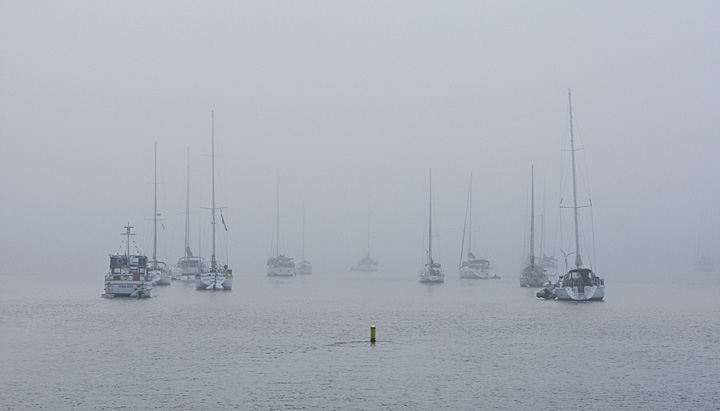Or, how changing conditions can change your photograph
As I stood on the fishing pier under
the bridge, a dinghy made its way towards me in the twilight. I had
composed, but I waited for the small boat to clear my frame. It
would have been a blur, a dark smudge, amongst the yachts, even though I had
increased the ISO to 800 to shorten the exposure time. When the dinghy
cleared, I made my first exposure. This first photograph was exposed
for five seconds, which can be seen in the blur of the buoy in the
center foreground. Fortunately the yachts were still enough that
their motion is not apparent – their masts aren't blurred and
masthead lights aren't distorted. Even though it was fairly dark,
there is some detail visible, lit by the industrial-strength lights
on the shrimp docks some distance off to the the left.
The next photograph was made just a few minutes later, a little
before sunrise, with a nice pink sky. I had reduced the ISO to
200. The faster shutter speed, 1/2 second, made a difference in the buoy, as well as the texture of the water and the sky. The yachts are more in
silhouette due to the brightness of the sky. This might have been a
good candidate for a graduated neutral density filter to bring out
more detail in the yachts, and perhaps to lighten the dark band of fog beyond, without overexposing the sky.
A fellow carrying his morning coffee walked up to me on the pier
and struck up a conversation. He lives on one of the yachts I had
been photographing. He pointed it out to me, but I was never really
sure which one was his. I asked if he had come in on that
dinghy earlier. He said that he had, that he was bringing his wife in so
she could go to work. He told me all about how he had sold the house
and bought the 40-year-old boat, and had been working on it, fixing
it up. When he finished getting it ready they were going to let it
take them down through the Caribbean and along the coast of South
America. We chatted for a while and then he excused himself to go
get his second cup of coffee. The fog bank that had been beyond the
anchorage was rolling in, engulfing the yachts. I made my final
exposures. Less than an hour had elapsed
since exposing the first photograph. Changing conditions had given me three different photographs of the same scene. Time for my second cup, too.
Some technical stuff about white balance-
All three of these photographs were made with a manual white balance setting of 5500K, which approximates a daylight setting. The colors you see are just as they were captured by the camera. Automatic white balance, AWB, would have warmed the first photo, cooled the second, and I think it would have slightly warmed the third. That is, AWB would have reduced the apparent differences in color among these photographs. When I first started shooting digital, a set the white balance to daylight - after all, I'd been shooting daylight balanced color film for years. It's what I was used to. Later I set the white balance to AWB. When I started doing portraits, I discovered that AWB would react to to a change in clothing color or background by changing the apparent coloring of the photographs. For consistency, I stopped using AWB and now almost always use the manual setting. By shooting RAW rather than JPEG, I can always adjust the white balance in post-processing if I need to.
© 2012 Buck Ward The Photographist www.buxpix.net




No comments:
Post a Comment